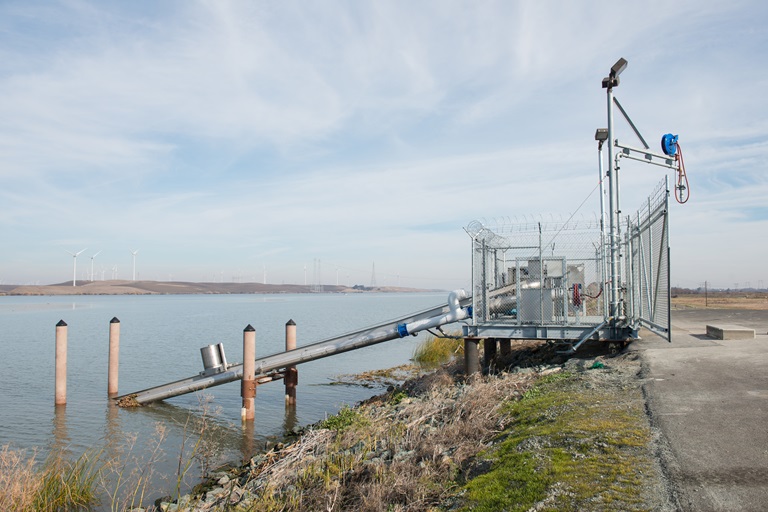Construction Wraps Up for 2 New Fish Release Sites in the Delta
Construction is nearly complete on two new fish release sites, Little Baja and Manzo Ranch (shown here), on the northwest side of Sherman Island in Rio Vista, California. DWR/2017.
Thanks to the helping hand of two new state-of-the-art fish release sites in the Sacramento-San Joaquin Delta, salvaged fish from the John E. Skinner Delta Fish Protective Facility will now have better odds of survival as they return to Delta water.
The new fish release sites, Little Baja and Manzo Ranch, add to the existing four fish release sites in the Delta and will be operated jointly by DWR and U.S. Bureau of Reclamation (Reclamation).
“These sites provide greater flexibility in release options so we can meet our obligations under the 2009 National Marine and Fisheries Services’ Biological Opinion,” said DWR Bay-Delta Office Senior Engineer Kathleen Buchnoff, who has been project manager since 2011. “The Biological Opinion mandates that we reduce predation of salvaged fish and increase their survival rates.”
The new sites were designed based on the previously reconstructed Curtis Landing fish release site design and the latest technology to improve survivability.
“The key to the project’s success has been multi-disciplinary, cross-departmental collaboration, and fostering open communication with many external agencies and partners,” said Buchnoff.
The two new sites, expected to be completed in March, are located on the Sherman Island levee along the Sacramento River near Rio Vista between Highway 160 and Sherman Island County Park.
How It Works, and What Is New
When fish haul trucks arrive to a release site, the fish release system is activated and the operator connects the truck to the release system. Two parallel pipes that run from the top of the levee to the Sacramento River begin to cycle water from the intake pipe through the release pipe. Once flows are steady, fish begin to move through the pipe and are released to the river.
A key feature of the new design is the increase in flow following a release, from 0.5 cubic feet per second (cfs) to 3.5 cfs.
“Studies show that equipping the release pipes with larger flows and implementing operational procedures to effectively flush the release pipe can prevent predators from gathering at the end of the pipe to feed on salvaged fish,” said Buchnoff.
According to Buchnoff, the release systems are designed with minimal structures in the water to lower the odds of debris getting caught on them and make it a less attractive hideout for predators.
Other significant features added to the new sites include: new asphalt pads and asphalt levee access road for the trucks, automatic interior and exterior brushed fish screen cleaning systems to reduce debris accumulation, widened levee and paved levee roads for the truck operators, automated gates and fish monitoring equipment including passive integrated transponder tag antennas on the fish release pipes, and a camera mount on the fish screen.
“The camera mount is for an underwater sonar camera that will be used to monitor the presence or absence of predatory fish at the release sites,” said Engineer Roger Padilla.
Joint Use
Little Baja and Manzo Ranch will also be available for Reclamation release operations. The new facilities were designed to accommodate federal and State needs.
“Combined with the Reclamation's fish release sites, there are now a total of six facilities in the Delta where State and federal releases can be made,” said Buchnoff. “More sites allows for more time in between releases.”
“The new sites will allow the flexibility to test various release site rotation schemes with the aim of reducing predation on salvaged fish,” said Supervising Senior Environmental Scientist Javier Miranda.
“We hypothesize that by changing how we rotate releases among the sites or by increasing the amount of time between when each site gets used, we will prevent predators from learning to gather at the release sites for an easy meal,” said Miranda.
Looking ahead, Reclamation plans to construct one new fish release site in the future, and DWR will retire one of its sites constructed in the 1970s.
by Christina Jimenez, DWR Information Officer
